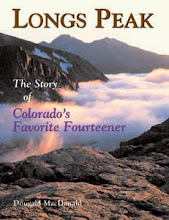 I've been thinking about the avalanche last week near Mont Blanc that killed eight climbers. I was on the slopes of Mont Blanc du Tacul just last September, approaching the Chèré Couloir , an ice line on the triangular rocky buttress just left of the slopes that avalanched. As we walked up toward the base of the climb, my partner, John Harlin, cautioned me against wandering too close to the ice slopes to our right. At the time this seemed silly. Sure, I could see the big seracs perched overhead, but there were dozens of people plodding up and down the climbers' track that zigzagged along the face that morning. How dangerous could it be?
I've been thinking about the avalanche last week near Mont Blanc that killed eight climbers. I was on the slopes of Mont Blanc du Tacul just last September, approaching the Chèré Couloir , an ice line on the triangular rocky buttress just left of the slopes that avalanched. As we walked up toward the base of the climb, my partner, John Harlin, cautioned me against wandering too close to the ice slopes to our right. At the time this seemed silly. Sure, I could see the big seracs perched overhead, but there were dozens of people plodding up and down the climbers' track that zigzagged along the face that morning. How dangerous could it be?
Avalanche professionals are well aware of the perils of this sort of thinking. When a steep slope is carved up by ski tracks, it must be safe, right? After your buddy skis an unbroken field of powder, it obviously ain't gonna slide, right? Avalanche pros urge skiers to make their own decisions, but humans are herd animals and there is a false sense of safety in numbers.
I remember walking toward Windy Corner on Denali and passing enormous green blocks of ice along the climbers' trail. These desk-size ice boulders had obviously tumbled thousands of feet down the West Buttress and would have obliterated anyone traversing the slope. We hurried past this spot as quickly as our lungs and tired legs would allow, yet two separate parties of climbers had chosen to stop here for lunch, leaning their bodies against the ice blocks that seemed to have been placed there like magical back rests.
The dangers of the herd mentality are greater on often-guided peaks like Mont Blanc. The average climber thinks: If the guides are going up, it must be safe. But even though professional guides may have the background and skills to assess the risks better than you or I, they're still tossing the dice each time they traverse a slope under seracs. It's still a gamble.
The risks on Mont Blanc du Tacul are well-known. An avalanche in almost the exact same spot killed a climber as recently as 2005. But last week it was quickly back to business as usual on this slope, one of the standard routes toward Western Europe's highest peak, with numerous parties criss-crossing the deadly avalanche debris, no doubt aware of the accident but unwilling to change plans. Sometimes humans aren't the smartest animals.
Tuesday, September 02, 2008
Avalanches: The Herd Mentality
Posted by
Dougald MacDonald
at
6:31 AM
![]()
![]()
Subscribe to:
Post Comments (Atom)








1 comment:
I've seen this same phenomenon: a large group having lunch or a long break right at the most objectively hazardous place on the entire route. Apparently they are completely unaware of the danger. Small as the chance may be, one should still try to minimize the risk.
Along the same lines, many climbers understand that objective hazards are random, but they then make the mistaken conclusion that their actions don't make any difference. In reality, there are still a huge number of things you can do to reduce your risk to objective hazards (like not having lunch right under a serac).
Post a Comment